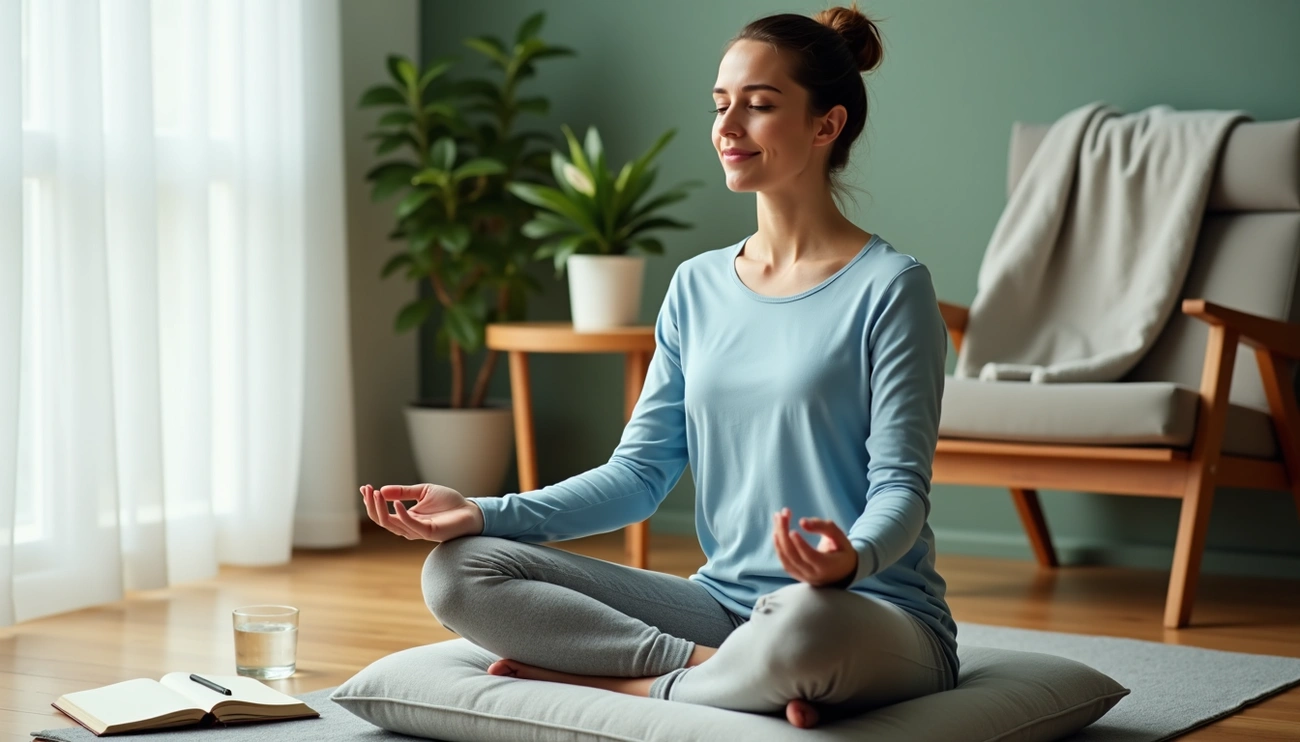Anxiety disorders touch the lives of up to 12% of Americans, with specific phobias representing just one type of anxiety that people struggle with daily
Anxiety can strike without warning and derail your entire day. Even simple tasks become overwhelming challenges.
The harder you fight against anxiety, the more it tends to grow. Your body’s nervous system interprets the worry about eliminating anxiety as another threat to defend against.
The experience can truly disable you, from racing thoughts to physical symptoms like a racing heart. Women face twice the likelihood of developing an anxiety disorder compared to men.
Anxiety’s grip can affect your daily life, work, relationships, and happiness by a lot if left unchecked. The good news? We’ve gathered doctor-approved techniques that help calm anxiety quickly and effectively.
These strategies align with your body’s natural systems, rather than working against them.
This piece shares eight proven methods to reduce anxiety right away. You’ll learn about anxiety symptoms’ mechanisms and know when to ask about treatment options for anxiety disorders.
These approaches can help you take back control and find relief, whether you face occasional stress or chronic anxiety.
What Anxiety Feels Like and Why It Happens
We all feel anxious at times – it’s a natural part of human nature. Learning what happens during anxiety can help us handle it better.
Common emotional and physical symptoms
Excessive, ongoing worry that disrupts daily life stands as anxiety’s trademark. People with anxiety worry too much about many things that don’t match the reality of events.
They often think about worst-case scenarios and feel like something bad will happen.
Your body changes noticeably when anxiety kicks in. Your heart beats faster, you breathe more quickly, and your muscles tense as your body prepares for what it perceives as danger.
You might also experience:
- Sweating and trembling
- Digestive issues like nausea or diarrhea
- Fatigue and sleep disturbances
- Dizziness or feeling faint
- Chest tightness or pain
These physical symptoms can make emotional distress worse, which creates a tough cycle to break.
How anxiety is different from everyday stress
Anxiety and stress might feel similar, but they work differently. Stress usually arises from a specific situation—such as a deadline or a significant life change—and dissipates when the problem is resolved.
Anxiety often stays around without an apparent reason or continues well after the stressful situation has passed.
The length and strength of these feelings set them apart, too. Every day stress doesn’t last long and matches what’s happening. Anxiety tends to be too intense and can stick around for months.
Stress responds to things happening in the present. Anxiety makes you worry about future events that might never occur.
Understanding the fight-or-flight response
Our body’s ancient survival system – the fight-or-flight response – powers anxiety’s symptoms. Your brain triggers a flood of hormones, mainly adrenaline and cortisol, when it senses danger – whether real or imagined.
The amygdala starts this process by sending warning signals to the hypothalamus. Your sympathetic nervous system then jumps into action.
It speeds up your heart rate, dilates your pupils, and sends blood to your muscles. Your body prepares to either face the threat or run from it.
Modern concerns, such as public speaking or financial worries, can unnecessarily keep this system running. This extended activation often leads to chronic anxiety.
8 Doctor-Approved Ways to Reduce Anxiety Immediately
People need quick relief at the time anxiety strikes. These doctor-approved techniques will help you take back control.
1. Deep breathing to calm your nervous system
Your parasympathetic nervous system responds directly to controlled breathing. This counteracts the fight-or-flight response. Exhaling longer than inhaling triggers relaxation.
A good pattern is breathing in for four seconds and out for six. Your body will naturally calm down with this rhythm. The best results come from diaphragmatic (belly) breathing, where your stomach expands instead of your chest.
2. Grounding techniques to stay present
These techniques shift your focus from overwhelming thoughts back to the present moment. The 5-4-3-2-1 method engages all your senses: identify five things you see, feel four things you can touch, notice three sounds you hear, identify two scents you smell, and taste one thing.
Physical grounding helps too – press your feet hard against the floor or hold something cold to break anxiety’s grip.
3. Use of mantras or positive affirmations
Short, powerful phrases can stop anxious thoughts. Research indicates that mantra meditation can help alleviate stress and anxiety.
Good affirmations include “I am safe and in control,” “This feeling is temporary,” or “I’ve handled this before.” Say your chosen phrase quietly or out loud several times and focus on what it means.
4. Quick physical activity to release tension
Anti-anxiety effects can be achieved with just five minutes of movement. Your body releases tension and produces endorphins, which naturally lift your mood. Take a brisk walk, do jumping jacks, or stretch.
Research shows regular exercise helps some people reduce anxiety as much as medication does.
5. Visualization or guided imagery
Your senses respond to pleasant mental images that help you relax. Research proves this gives quick relief from anxiety symptoms.
Picture a peaceful place with your eyes closed – one that evokes a beach with soft sand and gentle waves. Let yourself see, hear, smell, and feel every detail of this calming scene.
6. Change your environment or posture
Your emotional state changes in relation to your physical position. Studies show that sitting up straight helps maintain self-esteem and improves mood better than slouching does. A simple change in posture or location can break anxiety’s hold and give you a fresh view.
7. Use a mental break or distraction
The right kind of distraction can effectively stop anxious thoughts. Try naming items in groups (like fruits you know), count backward from 100 by sevens, or recite something familiar.
These tasks redirect your mind away from worries.
8. Talk to someone you trust
Sharing your feelings brings quick relief from anxiety. A good talk helps sort out problems and find solutions you might miss on your own.
Lifeline (13 11 14) offers 24-hour support from trained professionals if you need someone to talk to.
Lifestyle Habits That Lower Anxiety Over Time
Simple lifestyle changes can bring lasting peace to your daily life, going beyond quick fixes for anxiety.
Exercise and movement routines
Physical activity naturally reduces anxiety. Research shows that more frequent and intense training, especially weight training, substantially lowers anxiety levels. Your brain releases endorphins—natural mood elevators—during exercise while reducing stress hormones like cortisol. You should aim for at least 150 minutes of moderate activity or 75 minutes of vigorous activity per week for the best results.
Sleep hygiene and caffeine reduction
Insufficient sleep makes anxiety worse. Athletes who sleep better consistently exhibit lower anxiety levels. Caffeine can make anxiety symptoms worse by increasing heart rate and stress hormones. You should avoid caffeine at least 6 hours before bed since studies show it can reduce sleep by more than one hour, even with this gap.
Mindfulness and meditation practices
Mindfulness-Based Interventions (MBIs) work better than non-evidence-based treatments to reduce anxiety. These methods teach you to react less to unpleasant internal experiences.
A daily mindfulness practice of just 10 minutes can help alleviate anxious thought patterns.
Healthy eating and hydration
Dehydration can exacerbate feelings of anxiety. People who drink more water and eat whole grains tend to feel less nervous. Staying hydrated is a simple yet powerful way to manage anxiety.
Limiting screen time and news exposure
Too much screen time links strongly to anxiety symptoms. Teens who spend more than four hours daily on screens show higher anxiety levels.
Screens’ blue light blocks melatonin production and can make anxiety worse by disrupting sleep.
When to Seek Professional Help
You need to know when professional help becomes necessary for anxiety, just like you need coping strategies.
Signs your anxiety may be a disorder
Anxiety might need professional attention if it lasts two or more weeks and gets in the way of your daily life. Anxiety disorders differ from regular anxiety – the feelings stay around, happen often, and feel much stronger than usual.
Your body may indicate something’s wrong through persistent headaches or stomach issues. You might start avoiding certain situations out of fear.
The most enormous red flag shows up when anxiety starts driving your life choices instead of your priorities.
Options for therapy and medication
Cognitive Behavioral Therapy (CBT) leads the way as the most effective treatment for anxiety disorders. Doctors usually start with selective serotonin reuptake inhibitors (SSRIs) to treat moderate to severe cases.
Benzodiazepines offer quick relief, but doctors prescribe them briefly because they can cause side effects and become habit-forming. The best results often come from mixing therapy with medication.
How to prepare for your first appointment
Your first visit will go more smoothly if you write down your symptoms beforehand. Please include details about when they happen and what helps or makes them worse.
Make a note of any stressful life events, your family’s mental health history, and medications you take. Bring questions about treatment choices, costs, and the expected duration of the process.
The first session helps your provider understand your situation and map out the next steps. Feeling nervous about going is natural – finding the right professional is a vital step to managing your anxiety better.
Conclusion
Anxiety can feel overwhelming sometimes, but you can find relief through these techniques. Understanding anxiety’s physical and emotional signs helps us respond well instead of worrying more. The eight doctor-approved methods—from deep breathing to talking with someone you trust—give you immediate tools when anxiety hits.
Despite that, you need more than quick fixes to manage anxiety long-term. Your body becomes more resilient to stress through regular exercise, good sleep habits, mindfulness, and healthy eating. These lifestyle changes support each other and build your defense against anxiety over time.
Anxiety exists on a spectrum. Every day life includes occasional anxiety, but symptoms that disrupt your daily life might mean you need professional help. Therapy, medication, or both are a great way to get relief when self-help strategies aren’t enough.
You’re not alone in this struggle. Millions of people face these challenges every day and still find ways to cope and thrive. Relief often starts when you acknowledge your feelings and try just one technique from this piece.
Take your time to see what works best for your situation. Your journey toward calmer days begins with these small yet meaningful steps.
Key Takeaways
When anxiety strikes, these doctor-approved techniques can provide immediate relief and help you regain control of overwhelming feelings.
• Practice the 4-6 breathing technique: Inhale for 4 seconds, exhale for 6 seconds to activate your body’s natural relaxation response
• Use the 5-4-3-2-1 grounding method: Identify 5 things you see, four you touch, three you hear, two you smell, one you taste to stay present
• Move your body for instant relief: Just 5 minutes of physical activity releases tension and produces natural mood-elevating endorphins
• Build long-term resilience: Regular exercise, quality sleep, mindfulness practice, and proper hydration create lasting anxiety protection
• Seek professional help when needed: If anxiety persists for 2+ weeks or interferes with daily activities, therapy and medication can provide significant relief
Remember, anxiety affects millions of people, and these evidence-based strategies work with your body’s natural systems rather than against them. Start with one technique that resonates with you—small steps lead to meaningful change in managing anxiety effectively.

